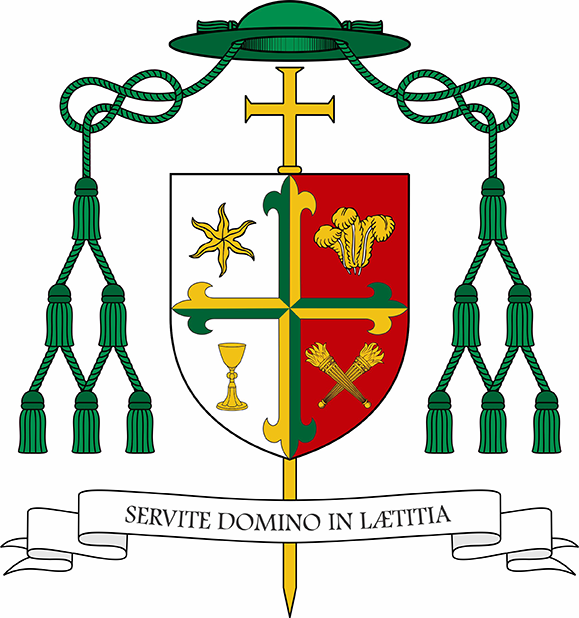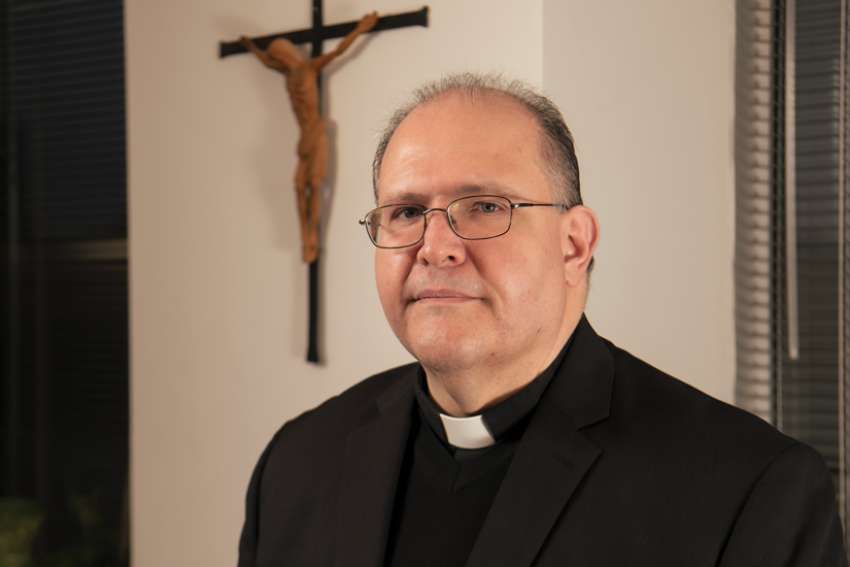Camilleri never boasts, but he does concede he has one particular, rare spiritual aptitude. He stays in the moment. His focus is perpetually on the here and now. In prayer, in serving others and in seeking the good, Camilleri stays in the present.
“I don’t spend too much time thinking about the past or the future,” Camilleri told The Catholic Register. “What am I doing now? There’s a certain contentedness, a sense of consolation, in the present moment.”
On Jan. 25 before a slimmed down, invitation-only, COVID-cautious congregation at St. Michael’s Cathedral Basilica (live-streamed at 2 p.m.), the 51-year-old Camilleri will be ordained a bishop — beginning a new chapter in his life of service as the Archdiocese of Toronto’s Auxiliary Bishop for the western region, covering most of Etobicoke, Mississauga and Brampton.
For nearly 10 years, Camilleri has been the archdiocese’s chancellor of spiritual affairs, moderator of the curia and vicar general, while also serving as a judge on Toronto’s marriage tribunal. In other words, he’s been Cardinal Thomas Collins’ right hand in guiding and managing Canada’s largest diocese, and one of the world’s most diverse.
“If I can be of service to my bishop, if I can be of service to the people, then I’m happy with what I’m being asked to do."
“This call to service kind of resurfaces,” Camilleri explained after accepting the call from Pope Francis. “If I can be of service to my bishop, if I can be of service to the people, then I’m happy with what I’m being asked to do. That’s really where I think that excitement and joy comes from.”
Collins praises this devotion to service in his new auxiliary.
“Bishop Camilleri has shown extraordinary devotion to the service of Our Lord and His people,” said the cardinal. “He truly has the heart of a pastor, always available in the service of others. Our archdiocese will truly be blessed as he now enters into his new apostolic mission.”
Excitement might not be the first thing people think of upon meeting Camilleri, who calls himself an introvert.
“I’m very introverted,” he said. “I would prefer solitude to being in the middle of a crowded place. But the draw to service is definitely a draw to community.”
Camilleri rarely watches movies, doesn’t have a Netflix account and watches TV almost exclusively for the news. Beyond keeping up with developments in canon law, his bookshelf is entirely devoted to information — no novels. The most recent book on his nightstand was not far removed from a policy briefing — Ten Lessons for a Post-Pandemic World by Fareed Zakaria.
“I tend to read books that maybe stimulate me intellectually,” he explained.
Among his fields of interest, he is fascinated by egyptology and ancient history generally.
Camilleri’s fearsome focus once drove a career in finance that saw him head up Bell Canada Enterprises’ mergers and acquisitions operations when he was barely into his 30s. Having 50 employees under him and ferrying millions of dollars through the complex processes was interesting. It presented problems he enjoyed solving. But it wasn’t exactly what his heart yearned for.
Looking out his window at BCE Place on Bay Street in downtown Toronto, Camilleri could see homeless people sleeping on grates, enveloped in steam coming up from the subway tunnels.
“What’s more important in life, this career or those people?” he asked himself.
So in 2001, at 32, Camilleri put his career on pause for a year to see whether the seminary might answer his question. He immediately felt at home on the bluffs overlooking Lake Ontario at St. Augustine’s Seminary. By 2007 he had a Bachelor of Sacred Theology and a Master’s of Divinity degree. He was ready to be ordained by Collins.
His first pastoral assignment was at Merciful Redeemer in Mississauga, but then he was almost immediately tapped for further studies.
In 2011 he collected a licentiate in canon law from Catholic University of America in Washington, D.C.
Canonists make good bishops because caring for the whole community is fundamental to canon law, said Canadian Canon Law Society president Fr. Michael Fahlman.
“You have to love the law, but you have to love the people of God more.”
“It helps facilitate harmony and respect for others. It is an essential part of a bishop’s ministry, to bring unity among people and help them grow and mature in their faith,” Fahlman said.
Camilleri sees canon law as “a pastoral tool.”
“You have to love the law, but you have to love the people of God more,” he said.
The idea that canon law is all about the rigid, unstinting application of hard and fast rules is the worst sort of misconception, according to Camilleri.
“You are trying to apply it in a way which is for the assistance of people — not to be a burden to them,” he said. “To truly apply the law you need to think beyond the black and whiteness of the law. The real application of the law is in the many shades of grey.”
Camilleri is the son of a Maltese diplomat and a piano teacher. The family came to Toronto in 1980, when Camilleri was 12. He learned from his father Ben a deep appreciation of loyalty and leadership and from his mother Josephine the habits of hard work and quiet determination, said Harold Camilleri, eldest of their three sons.
“He’s not only a holy priest, dedicated to the Church,” said Harold. “But he’s a really smart, well-organized person who gets things done. … You can count on Ivan. If Ivan says he’s going to do something he will do it.”
When, at the end of high school, Camilleri was unsure what he wanted to do, his parents packed him off to Sudbury to study for a Bachelor of Commerce at Laurentian University, where Harold was already studying. He lived upstairs and Harold downstairs in a house off campus. The two focused almost entirely on their studies.
In Sudbury Camilleri began thinking about priesthood, a calling that had come to four of his cousins, including Bishop Walter Ebejer. O.P., from Brazil, the bishop emeritus of the Diocese of União da Vitória, in the state of Paraná. But on finishing his B. Comm., Camilleri went on to study for his MBA at the Edinburgh Business School. That second degree naturally segued into a job, then one job into the next, while the question of priesthood still lurked in his heart and mind.
“I got into bargaining (with God),” Camilleri told Catholic Register reporter Sara Loftson in 2007 on the eve of ordination. “If you let me finish my degree, I’ll consider the priesthood.”
“I never dwell on whether I need more of this or less of that. I ground myself in the present and I find usefulness in whatever the present moment is.”
Soon to turn 52, Camilleri has put that youthful hesitation into the past.
“I never dwell on whether I need more of this or less of that. I ground myself in the present and I find usefulness in whatever the present moment is,” he said.
He describes his spiritual life in terms that are straightforward, simple and direct. Praying in front of the Eucharist in a darkened, quiet church is a regular practice. There’s “a Marian component” that he keeps close to his heart. His breviary and its daily round of morning and evening prayers keeps him grounded. He puts everything he has into praying the Mass.
As he describes his prayer life, Camilleri concedes that it sounds monastic.
“But it’s monastic in the context of one’s world and one’s work. That’s the spirituality I have,” he said. “It’s simply making use of the present moment in prayer. It’s a very eucharistic spirituality.”
The commitment to priesthood and now service as a bishop is equally straight-forward.
“I enjoy being a priest. I enjoy helping people, administering the sacraments,” he said.
Why?
“For me, it was always a call to service,” he said. “It was always a call to serve others, to serve other people. That was really the attraction of priesthood.”
(NOTE: This story has been update to correct the reference to Bishop Camilleri's cousin, who is Bishop Walter Ebejer.)
The new bishop’s official coat of arms

The coat of arms is the emblem of the bishop and is used on his letterhead and official publications. Each is unique, representing the person’s interests, and is composed of four elements: shield, cross, green hat and a scroll with a motto:
Arms
The shield is split into two halves with a white and red background. These colours represent Bishop Camilleri’s Maltese origin, Canada and the Archdiocese of Toronto.
The main cross separating the shield into four quadrants is the St. Edward the Confessor cross with the colours symbolizing joy (green) and faith (gold).
The meaning of the symbols on the shield represent that we can only truly serve joyfully when we recognize God’s goodness (the star) and submit our will to Him serenely (the feathers). Our service has to be zealous (the torches) and strengthened by vigilance to the spiritual and sacramental life (the chalice).
Motto
Servíte Dómino in lætítia — Serve the Lord with gladness from the Psalm 100:2, it expresses the central theme to the bishops’ ministry as a priest.


